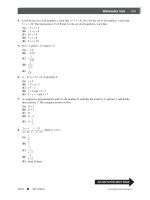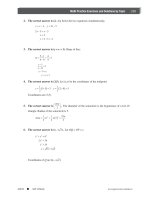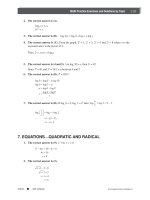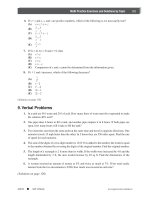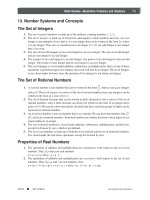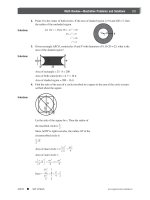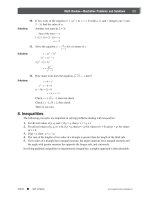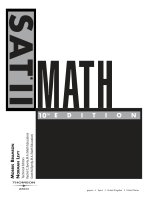SAT II Biology Episode 1 Part 9 docx
Bạn đang xem bản rút gọn của tài liệu. Xem và tải ngay bản đầy đủ của tài liệu tại đây (543.77 KB, 20 trang )
Cnidaria
Cnidaria include the sea anemone, hydra, jellyfish, and corals, which
secrete a hard coating around themselves for protection. There are
two morphological forms, the medusa and the polyp. The medusa is
free-floating. In some cnidaria, the two stages alternate throughout
their life cycle, with the polyp form producing the motile medusae
which produce the sperm and egg. Cnidarians are radially symmetri-
cal, have a digestive cavity with only one opening, and have a
two-layered body wall.
Platyhelminthes
Platyhelminthes are planarians, flukes, and tapeworms. Planarians are
free-living carnivores, flukes are either internally or externally
parasitic and live off the fluids of the host, and tapeworms are
internal parasites in the digestive tract of vertebrates. Tapeworms lack
their own digestive system. Platyhelminthes are radially symmetrical,
the digestive cavity has only one opening, and it is not a coelom or
pseudocoelom. There is no circulatory system. The body wall is
composed of three layers.
ORGANISMS AND POPULATIONS
157
Peterson’s n SAT II
Success: Biology E/M www.petersons.com
Nematodes
Roundworms are the first organism with a complete digestive tract;
many are free-living and help recycle nutrients, and several are
parasitic, such as the trichina worm. They are bilaterally symmetrical,
have a pseudocoelom, and have three tissue layers in their body wall.
They have a sac-body plan. They do have an organ level of organiza-
tion.
• Rotifer—microscopic with several specialized organs.
They are primarily filter feeders.
CHAPTER 6
158
Peterson’s n SAT II
Success: Biology E/Mwww.petersons.com
Annelid
The segmented worms include the leeches, a blood-sucking parasite;
the earthworms; and the polychaete worms, which occupy a mostly
marine environment. At this point in the taxa, the organisms are
becoming more and more complex by either possessing an entire
organ system or by one or more organ systems attaining significant
complexity. They are bilaterally symmetrical, have a true coelom and
are protostomes and have a complete digestive system and well-
defined nervous and circulatory systems.
Mollusk
Soft-bodied—although some possess a shell—this group includes the
snail, bivalve, octopus, and squid. Molluscans are unsegmented, have
a true coelom, and are protostomes. They are bilaterally symmetrical.
They have a head, a mantle, a 3-chambered heart, and a muscular
foot. All but bivalves have a radula.
ORGANISMS AND POPULATIONS
159
Peterson’s n SAT II
Success: Biology E/M www.petersons.com
Arthropod
The jointed-legged animals, they possess exoskeletons and include the
spiders, insects, crustaceans, the so-called “centipedes” or chilopods,
and millipedes or diplopods. Arthropoda is the largest animal phylum.
Arthropods are segmented and have paired, jointed appendages and a
complete digestive tract. They are protostomes. Arthropods have
cephalization with a ventral nerve cord and ganglia in each segment.
Echinoderms
Echinoderms include the sea stars, sea cucumbers, and sand dollars,
all of which have radial symmetry, although larval body shapes are
bilateral. Echinoderms have well developed coeloms. They are
deuterostomes. Echinoderms have an endoskeleton of calcareous
ossicles and a water vascular system with tube feet.
CHAPTER 6
160
Peterson’s n SAT II
Success: Biology E/Mwww.petersons.com
Chordates
These animals, the highest in the taxa and on the evolutionary scale,
all share the three following characteristics: (1) A flexible notochord
(rod) at some time in their development that provides support for the
nervous system and is located dorsally. The notochord is generally
replaced by a vertebral column. (2) Dorsal, hollow, nerve cord that in
some differentiates into a brain and spinal cord. (3) Pharyngeal gill
slits that allow oxygen-carbon dioxide exchange. In the higher
organisms, the pharyngeal gill slits appear mainly as pharyngeal folds.
There is also a muscular tail at some point in their development that
some lose as early as the embryonic stage. Chordates are deuteros-
tomes.
Subphylum—Vertebrate Classes
Vertebrates have a complete digestive system, a large coelom, and a
closed circulatory system. The sexes are generally separate. They have
an endoskeleton, paired appendages, and cephalization.
A. Pisces
Fishes are aquatic gill breathers. They usually have an air bladder.
Evidence indicates that the first vertebrates were fish-like.
B. Amphibian
Amphibians have four appendages. They usually have gills in the
larval stages and lungs in the adult. They undergo metamorphosis.
Amphibians are thought to have evolved from the lobe-finned fishes.
They have incomplete double circulation; a smooth, moist skin; and a
3-chambered heart. Amphibians were the first animals to live on land
and are ancestors of the reptiles.
ORGANISMS AND POPULATIONS
161
Peterson’s n SAT II
Success: Biology E/M www.petersons.com
C. Reptiles
Reptiles include turtles, lizards, snakes, crocodiles, and the extinct
dinosaurs. Reptiles have lungs; incomplete double circulation; a
shelled egg; dry, scaly skin; and are ectotherms.
D. Aves
Birds are homeotherms and have complete double circulation and a
skin covered with feathers. Their forelimbs are wings. They have air
sacs, a 4-chambered heart, and a hard-shelled egg.
E. Mammalian
Mammals include the oviparous animals, such as the duckbill platy-
pus; the marsupials, including the kangaroo; and the mammals that
have placentas. Placental mammals are homeotherms with body hair,
differentiated teeth, mammary glands, a diaphragm used in respira-
tion, and almost always seven vertebrae in the neck.
MULTIPLE-CHOICE QUESTIONS
1. The plant hormone responsible for fruit ripening is
(A) abscissic acid.
(B) auxin.
(C) cytokinin.
(D) ethylene.
(E) gibberellin.
2. Which of the following is found in all viruses?
(A) protein coat
(B) cell membrane
(C) membrane-bound organelles
(D) ER
(E) mitochondrial DNA
3. Which of the following categories includes the most distantly
related organisms?
(A) family
(B) species
(C) class
(D) genus
(E) order
CHAPTER 6
162
Peterson’s n SAT II
Success: Biology E/Mwww.petersons.com
4. In flowering plants, sperm are produced by the
(A) ovary.
(B) anther.
(C) microsporangium.
(D) sporophyte.
(E) generative nucleus.
5. Which of the following is not a type of plant stem?
(A) corm
(B) node
(C) rhizome
(D) tendril
(E) tuber
6. Gymnosperms are NOT
(A) seed plants.
(B) predominantly diploid.
(C) flowering plants.
(D) conifers.
(E) naked seed plants.
7. Viruses are
(A) always viewed with a light microscope.
(B) are an enzyme-nucleus mix.
(C) obligate, intracellular parasites.
(D) cellular.
(E) host independent.
8. An invertebrate is found in a freshwater setting and studies show
it to have three developmental body layers and a cuticle covering
its outer body. It belongs in the same phylum as the
(A) hydra.
(B) leeches.
(C) sea stars.
(D) sponges.
(E) crustaceans.
ORGANISMS AND POPULATIONS
163
Peterson’s n SAT II
Success: Biology E/M www.petersons.com
9. Which of the following have a visceral mass and a muscular foot?
(A) Medusoids
(B) Annelida
(C) Aschelminthes
(D) Mollusca
(E) Arthropoda
10. Which of the following is radially symmetrical and possesses
nematocysts?
(A) Porifera
(B) Coelenterates
(C) Mollusca
(D) Amphibians
(E) Polychaetes
EXPLANATIONS OF ANSWERS FOR MULTIPLE-CHOICE QUESTIONS
1. The correct answer is (D). Ethylene promotes the ripening of
fruit and the production of flowers. Auxins promote the elonga-
tion of certain cells and helps in the growth of the plant, mainly
in the tips of shoots and roots. Gibberellins promote cell growth
and fruit development—not ripening—and seed development.
Cytokinins stimulate cell division. Abscissic acid delays seed
germination and bud development.
2. The correct answer is (A). Of the structures listed, all viruses
are found within a protective protein coat. All of the other
structures are found in eukaryotic cells: a cell membrane to act
as a barrier to things entering the cell; ER, which refers to the
endoplasmic reticulum, the canal system of the cell, and the site
where protein synthesis takes place; membrane-bound organelles
is self-explanatory; and mitochondrial DNA is found in the
mitochondria.
3. The correct answer is (C). The most specific group listed is
the species and includes organisms that are virtually identical to
each other, with slight variations. They have the same structures,
act alike, and can mate and produce offspring that can mate. This
group has the most closely related organisms. The next group,
less specific than the species, is the Genus. The genus Canus, for
example, includes all the dog-like organisms—wolf, coyote, and
the domesticated dog. The family level is one up from the Genus
and lies several levels below class, which means it has more
widely varied examples than the Genus level but far fewer than
the class level. Class is the group with the most widely varied
CHAPTER 6
164
Peterson’s n SAT II
Success: Biology E/Mwww.petersons.com
organisms. For example, the class Mammalia of the phylum
Chordates includes elephants, tigers, bears, cats, dolphins, and
humans.
4. The correct answer is (B). The anther is associated with the
production of sperm in flowering plants, but, more specifically,
the structure more closely identified with sperm production in
the anther is the generative nucleus. Sporophyte refers to the
dominant generation among the plant kingdom species and
involves the entire organism. All other parts are associated with
the female structures. The ovary is where the egg is produced
and fertilized and will become the embryo; the megasporangium
produces the mother spore cell in tracheophytes that leads to
the production of the four haploid cells, one of which will
become the egg; and the stigma is the place where pollen grains
fall and ultimately grow a pollen tube to the ovary. It is sup-
ported by the stigma; both are female reproductive structures.
5. The correct answer is (B). A node is a site on the stem where
leaves attach—and unattach—at the end of the growing season.
They are not, therefore, an example of a stem. Of the other
items in the question, all of which are a type of stem, tendrils
assist climbing plants as attachment points and tubers; rhizomes
and corms are all examples of underground stems. Tubers store
large amounts of starch, as in the potato; rhizomes are found in
ferns and are involved in vegetative propagation; and corms are
specialized leaves that can store food.
6. The correct answer is (C). Gymnosperms have what are often
referred to as “naked seeds,” but they are seeds nonetheless. Like
all tracheophytes, they are predominantly diploid and they
bear—both the smaller male and the larger female—cones.
However, a gymnosperm is not an angiosperm or a flowering
plant.
7. The correct answer is (C). In order to reproduce, viruses need
cells that they can invade. These two facts make them obligate
and parasites. In addition, they are found intracellularly, taking
over the cell only for the purposes of reproduction. In order to
see viruses, they must be viewed with an electron microscope
since they are smaller than bacteria. It is also well known that
they contain a protein coat and a piece of DNA, not enzymes and
certainly not a nucleus. They are also not cellular entities, and
since they are not free living, they are definitely host dependent.
Host dependent can mean they need a host to survive, or it can
mean they need a host to reproduce. In the case of this question
and the choices given, the latter is taken to mean host depen-
dent here.
ORGANISMS AND POPULATIONS
165
Peterson’s n SAT II
Success: Biology E/M www.petersons.com
8. The correct answer is (E). The organism in question cannot be
an echinoderm, as they are exclusively marine, so it is not a sea
star. Sponges and coelenterates do not have a middle body layer,
and annelids do not have an outer cuticle. Crustaceans match the
description given in the question.
9. The correct answer is (D). Mollusks include the bi-valves,
which possess considerable visceral mass, and a muscular foot
with which they burrow and use for movement. Medusoids
include the very simple body planned coelenterates, such as
hydra and jellyfish, and lack significant visceral mass—if what
they possess can be called that. Annelids do not have a muscular
foot, and their viscera, while well developed, is not as substantial
as a bi-valve’s. Aschelminthes is a roundworm with more viscera
than the cnidarians, but still considerably less than even the
annelids. Finally, the arthropods are jointed-legged creatures and
do not possess a single, muscular foot.
10. The correct answer is (B). Coelenterates, such as the jellyfish
and the sea anemone, are well known for their radial symmetry
and their stinging cells. Porifera have no symmetry. All the rest of
the choices have bilateral symmetry—polychaetes are segmented
worms that are predominantly marine; molluscs include octo-
puses and squid, neither of which have stinging cells; and
amphibians are chordates with neither radial symmetry nor
stinging cells. Some frogs secrete powerful toxins through their
skin, but none of the cells in their skin has the ability to sting.
CHAPTER 6
166
Peterson’s n SAT II
Success: Biology E/Mwww.petersons.com
VOCABULARY
abdomen
abscissic acid
aerobes
algae
alternation of generations
amoeba
angiosperm
animal
animalia
annelid
anterior
anther
apical
arachnida
auxins
bacillus
bacteria
basidium
bilateral
binomial nomenclature
blastospore
bread mold
bryophyte
budding
bulbs
cambium
cephalization
chilopoda
chitin
chordata
cilia
class
cnidaria
coccus
coelenterate
coelom
crustacean
cyanobacteria
cytokinins
day-neutral
deuterostome
dicots
diploid
diplopoda
dorsal
echinoderm
ectoderm
egg nucleus
endoderm
endosperm
ethylene
euglena
facultative anaerobes
family
filament
flagellum
fruiting body
fungi
gametophyte
genus
gibberellins
grafting
gravitropism
gymnosperm
haploid
hyphae
insecta
kingdom
legumes
lenticels
lichen
Linnaeus
liverworts
long-day plant
mantle
meristem
mesoderm
mildew
mollusca
monera
monocots
mosses
mycelium
mycorrhizae
N2-fixing bacteria
nematode
ORGANISMS AND POPULATIONS
167
Peterson’s n SAT II
Success: Biology E/M www.petersons.com
obligate anaerobes
order
ovary
ovule
paramecium
parasite
penicillin
petals
phagocytosis
phloem
photoperiodism
phototropism
phylogeny
phylum
pilli
pistil
plantae
platyhelminthes
polar nuclei
pollen
porifera
posterior
protista
protostome
pseudocoelom
radial
roots
rotifer
runners
saprophytes
segmentation
sepals
short-day plant
sieve tubes
species
sperm nucleus
spirillus
spores
sporophyte
stamen
stigma
style
symbionts
symmetry
taxonomy
thigmotropism
thorax
tracheids
tracheophyte
tropisms
truffle
tubers
vascular
ventral
viruses
xylem
yeast
CHAPTER 6
168
Peterson’s n SAT II
Success: Biology E/Mwww.petersons.com
Chapter 7
ANIMALS—STRUCTURE AND FUNCTION
OVERVIEW
In Chapter 6 we mentioned that the material you will encounter in
each chapter of this book will relate to material you will find in other
chapters. In biology, everything is interrelated. To this end, you may
find that some of this material is repetitious, but repetition is never a
detriment to learning. In this chapter we will outline the animal
systems, focusing on human systems. A broad area not discussed in
this outline is that of hormones in heterotrophs other than humans.
You should be familiar with the area dealing with pheromones,
sex attractants, and territorial marking. A word about cell differentia-
tion—or specialization—in multicellular organisms is appropriate
here: The good news is that cells are specialized to do what they do
very well. The bad news is that all those specialized cells have
become interdependent, thus the discovery of increasingly complex
systems in increasingly complex organisms. Students should also be
familiar with the sequence from cell—tissue—organ—system—
organism and homeostasis.
DIGESTIVE SYSTEM
HUMANS
Large nutrient molecules are not usable by heterotrophs; they must
be broken down into smaller molecules that are capable of being
used by cells. This is the part of digestion called catabolism, which
includes two main types: mechanical and chemical. For the most part,
mechanical starts the process in most organisms, with chemical
becoming increasingly prevalent as the process proceeds. Digestion—
more specifically catabolism—replaces the water molecule in a
process called hydrolysis, which is the reverse of dehydration
synthesis—an anabolic reaction—where water is removed from
molecules as polymers are formed. Digestion also includes the making
of smaller pieces of nutrients from larger pieces to facilitate absorp-
tion, as in the case of fat molecules. The second process discussed
here, of course, is absorption of the catabolized nutrients. In humans,
mechanical and chemical digestion both start in the mouth or oral
cavity. Chewing is aided by the teeth, the tongue, and even the
cheeks and lips as they help position the food. The teeth help to tear,
169
Peterson’s n SAT II
Success: Biology E/M www.petersons.com
shred, and grind the nutrients, which increases the surface area. For
example, the surface area of a cube that is 1cm on a side is 6cm
2
.If
we cut it into 1,000 pieces—each having a .1cm on a side—the
surface increases tenfold to 60cm
2
. Thus, mechanical digestion clearly
aids chemical digestion.
In the mouth, the carbohydrates are acted on with amylase, an
enzyme secreted by the salivary glands, that breaks the starch into
smaller polysaccharides. The pharynx is a connection between the
mouth and the esophagus. It houses, among other things, the flap of
skin called the epiglottis, which should close over the larynx and
trachea each time we swallow. Swallowed items will get tangled in
this area if one is breathing and swallowing at the same time. The
connection between the mouth and the stomach is the esophagus.
Nutrients are passed from the mouth to the stomach by peristalsis, a
series of alternate muscle contractions along the esophagus. One set
of smooth muscles rings the length of the esophagus and another set
runs vertically along its length. Each set of muscles has the capability
of alternately contracting. The effect is an opening and closing of a
section of the esophagus as food passes along its length. Contrary to
popular belief, this does allow humans to drink water upside down
and even in space.
CHAPTER 7
170
Peterson’s n SAT II
Success: Biology E/Mwww.petersons.com
At the entrance to the stomach, we find a sphincter muscle that
closes to keep materials in the stomach and to very briefly allow for
the slow passing of materials into the stomach. As it is anatomically
positioned so near the heart, it is called the cardiac sphincter.
Irritation and illness sometimes cause this sphincter to allow for the
reverse movement of material. In the stomach, proteins are acted
upon for the first time and physical breakdown continues. Pepsin, an
enzyme activated by the acid environment in the stomach, acts on
peptide bonds to begin the breakdown of proteins. Both substances
are secreted under the influence of hormones as well as by nerve
impulses. The lining of the stomach is protected by a balanced
secretion of mucus. The partially digested material, now known as
chyme, is gradually allowed to exit the stomach through the pyloric
sphincter in small amounts for further digestion in the upper portion
of the small intestine, where bile from the gall bladder and digestive
enzymes from the pancreas are secreted. As chyme leaves the
stomach, it is, of course, very acidic. As a digestive organ, the
pancreas secretes no less than four digestive enzymes that act on
proteins and lipids: trypsin, chymotrypsin, pancreatic amylase, and
pancreatic lipase, all packaged in an alkaline solution to neutralize the
acid from the stomach. The pancreatic fluid contains sodium bicar-
bonate, which changes PH into base. The digestive enzymes act to
continue the digestion of sugars and proteins. The pancreatic lipases
are aided by bile in acting on lipids. The liver produces bile—
manufactured from recycled RBCs—which helps to emulsify fat
molecules to promote absorption of certain fat molecules into the
lymph system in the villi of the small intestine. Beyond the one
section immediately distal to the stomach, the small intestine is
divided into two more distinct sections: Digestion as just described
will occur in the upper section and absorption of catabolized
nutrients will occur in the lower section through structures called
villi that resemble finger-like structures that project inward along the
ANIMALS—STRUCTURE AND FUNCTION
171
Peterson’s n SAT II
Success: Biology E/M www.petersons.com
length of the lower small intestine. The upper section continues the
digestion of all three major classes of nutrients. Peristalsis moves
material from the small intestine to the large intestine. The large
intestine is involved mostly in absorption of water and minerals.
Species of bacteria also reside in the large intestine and help manufac-
ture vitamin K, a component necessary for the clotting of blood. The
remaining material, called feces, is stored in the rectum for a short
time, and then exits the body through the anus.
COMPARATIVE
Most coelenterates subdue their prey with stinging cells and digest
through intracellular and extracellular digestion. As they burrow
through the soil, earthworms grind food mixed with soil in their
gizzards and pass it on to be absorbed in the intestines; the undi-
gested material then passes out of the body. Although not the same
structurally as earthworms, insects also possess a crop and a gizzard.
Gastric glands secrete digestive enzymes; absorption takes place
mainly in the stomach, after which undigested material is passed to
the intestine and exits through the rectum.
RESPIRATORY SYSTEM
HUMANS
Cellular respiration, a key energy-releasing reaction in living organ-
isms, requires oxygen and produces carbon dioxide. Carbon dioxide
is the gas that, through the production of HCO
3
, regulates breathing.
These two gases must be exchanged by way of the respiratory system
and the circulatory system. Air is filtered, warmed, and moistened as
it enters the nasal passage through the nose and then passes through
the pharynx on its way to the trachea. Air passes through the vocal
cords, which are housed in the larynx, on its way through the
trachea to the lungs. Ringed with C-shaped cartilage, the trachea has
structural integrity while at the same time being flexible. If it were
bony material, almost any blow that would strike this area could be
disastrous.
CHAPTER 7
172
Peterson’s n SAT II
Success: Biology E/Mwww.petersons.com
The trachea branches into two tubes called the bronchi, each of
which passes into the lungs through even smaller and more numer-
ous tubes called bronchioles. The main area for gaseous exchange is
the alveoli of the lung. Each lung consists of several lobes or sections.
The chest muscles, both inner and outer along with the diaphragm,
create volume changes in the lungs, which establish pressure
gradients between the outside air and the lung cavity.
The changes in pressure alternately force air in and out of the
lungs. Small sacs called alveoli form clusters like grapes and are
surrounded by capillaries, where gas exchange actually takes place.
Arriving at the alveoli, the blood contains large amounts of carbohe-
moglobin. This facilitates the diffusion of carbon dioxide into the
alveoli through a single cell layer separating the open area of the air
sacs and the capillaries. Housed in the air sacs is a large quantity of
oxygen that diffuses out of the air sacs into the capillaries. The
oxygen meets up with hemoglobin that recently dumped its carbon
dioxide to form oxyhemoglobin, which is then transported to the
cells that carry on cellular respiration. The reverse of this process
occurs in the cells.
ANIMALS—STRUCTURE AND FUNCTION
173
Peterson’s n SAT II
Success: Biology E/M www.petersons.com
COMPARATIVE
Protists achieve the proper gas exchange through simple diffusion of
gases with their immediate environment. Coelenterates achieve gas
exchange by diffusion through two cell layers. Annelids exchange
gases through a moist skin. Large numbers of the members of this
group flee their burrows during large amounts of rainfall since the
oxygen supply in the water that enters their burrows is soon de-
pleted. Insects flex their abdomen, causing oxygen and carbon
dioxide to be exchanged through openings called spiracles.
CIRCULATORY SYSTEM
HUMANS
Many substances need to be moved around the body, and the
circulatory system achieves it through the use of muscles. Humans
possess a closed circulatory system where the fluid for transport is
kept within transport vessels. Some leakage of the fluid portion of the
blood does occur, but it is picked up by the lymph system and
returned to the closed system. (Note: Leakage is a normal function
that allows nutrients to leave the capillaries and arrive at the cells.) In
the veins, we find valves every few centimeters that point in the
direction of the heart, so that when they close, blood is prevented
from back-flowing away from the heart. Muscle contractions in the
skeletal muscles push the blood forward, helping the blood to return
to the heart in the venous system.
Blood is transported away—Arteries Away—from the heart by the
action of the cardiac muscle in vessels called arteries. Blood is
returned to the heart with the aid of skeletal muscles in vessels called
veins and a series of valves in the veins. The veins and arteries
CHAPTER 7
174
Peterson’s n SAT II
Success: Biology E/Mwww.petersons.com
connect through the smallest vessels of all, called capillaries, the
sequence being heart—arteries—arteriole—capillaries—venule—
veins—heart. The heart, the main pumping organ in the circulatory
system, is actually two pumps in one. More accurately, one half beats
in concert with the other half, delivering blood to two separate areas
of the body. The right side of the heart receives low-oxygen blood in
the upper part, known as the atrium, and uses the lower part to
pump it through pulmonary arteries to the lungs in what is known as
pulmonary circulation. The left side of the heart receives high-oxygen
blood in the upper part, known as the atrium, and uses the lower
part to pump it first through the aorta—the largest artery in the
body—and then through arteries to the body.
Blood is a fluid that circulates oxygen, carbon dioxide, nutrients,
waste materials, hormones, vitamins, and anything else that the body
needs to transport. It is composed of about 55 percent liquid, known
as plasma; the rest consists of solid parts and includes erythrocytes,
leukocytes, and platelets. Blood types were discussed in an earlier
chapter.
COMPARATIVE
Protists “swim” in an environment that includes nutrients and
oxygen. This allows anything to diffuse in or out quite easily. Co-
elenterates, like the protists, exchange materials with their environ-
ment simply by diffusion. Annelids possess closed circulatory systems
that contain a simple muscular loop.
ANIMALS—STRUCTURE AND FUNCTION
175
Peterson’s n SAT II
Success: Biology E/M www.petersons.com
IMMUNE SYSTEM
HUMANS
The basic functions of the human immune system include recognition
of an invading entity as well as abnormal body cells, and the attempt
to eliminate them. Lines of defense against attack include the skin,
anti-microbial proteins, competing bacteria, cilia, and gastric juices.
In addition, humans have developed means of augmenting the
immune system through the use of vaccines, antibiotics, or the
passing of antibodies from one person to the next. In addition,
interferon has been identified as help in the invasion of viruses.
Macrophages and neutrophils engulf and digest invaders while the
B-cells and T-cells work in concert in both the interstitial areas, as
well as within cells, to eliminate the antigens. The organs involved in
human immune responses include the bone marrow and the thymus,
where interaction between B-cells and T-cells is mediated; lymph
nodes; the spleen; adenoids; and tonsils. Tissues in the appendix may
also have a role similar to the tonsils.
COMPARATIVE
The invertebrate phyla have various types of immune reactions;
among them is phagocytosis. Humans, on the other hand, modify
their immune system with augmentation.
EXCRETORY SYSTEM
Waste must not be allowed to accumulate in or around cells, so it is
gathered and eliminated by an excretory system. Homeostasis,
maintaining a steady state in humans, is a critical role of this system.
CHAPTER 7
176
Peterson’s n SAT II
Success: Biology E/Mwww.petersons.com
